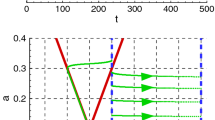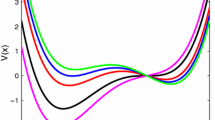Abstract
Of fundamental interest are the mechanisms by which neurons and other electrically excitable cells generate oscillatory activity and establish synchronized rhythms. Through quantitative modeling we seek to identify those biophysical factors (cell structure, ionic channels, biochemical pathways, and coupling functions) which play the most significant roles in determining cellular responses and collective behavior. From a generalist’s point of view we also seek qualitative understanding of the underlying mathematical structure of models in order to characterize the robustness of our results.
Access this chapter
Tax calculation will be finalised at checkout
Purchases are for personal use only
Preview
Unable to display preview. Download preview PDF.
Similar content being viewed by others
References
Atwater, L, Carroll, P., and Li, M.-X. (1988). Electrophysiology of the pancreatic B-cell. In “Insulin Secretion” (ed B. Draznin, S. Melmed, and D. Leroith), pp. 49–58. Alan R. Liss, Inc., New York.
Atwater, I., Dawson, C. M., Scott, A., Eddlestone, G. and Rojas E. (1980). The nature of the oscillatory behavior in electrical activity for pancreatic β-cell. J. of Horm. Metabol. Res. Suppl. 10, 100–107.
Atwater, I., Rosario, L. and Rojas E. (1983). Properties of calcium-activated potassium channels in the pancreatic β;-cell. Cell Calcium 4, 451–461.
Chay, T. R. and Cook D. L. (1988). Endogenous bursting patterns in excitable cells. Math. Biosci. 90, 139–153.
Chay, T. R. and Kang, H. S. (1988). Role of single channel stochastic noise on bursting clusters of pancreatic β;-cells. Biophys. J. 54, 427–435.
Chay, T. R. and Keizer, J. (1983). Minimal model for membrane oscillations in the pancreatic β-cell. Biophys. J. 42, 181–190.
Chay, T. R. and Lee, Y. S. (1990). Bursting-beating chaos by two functionally distinct inward current inactivations in excitable cells. In “Mathe matical Approaches to Cardiac Arrhythmias” (ed. J. Jalife). pp. 328–350. New York Academy of Sciences, New York.
Eddlestone, G. T., Gonçalves, A., Bangham, J. A., and Rojas, E. (1984) Electrical coupling between cells in islets of Langerhans in mouse J. Membrane Biol. 77, 1–14.
FitzHugh, R. (1961). Impulses and physiological states in theoretical models of nerve membrane. Biophys. J. 1, 445–466.
Gray, C. M. and Singer, W. (1989). Stimulus-specific neuronal oscillations in orientation columns of cat visual cortex. Proc. Natl. Acad. Sci. USA 86, 1698–1702.
Henquin, J. C. and Meissner, H. P. (1984). Significance of ionic fluxes and changes in membrane potential for stimulus-secretion coupling in pancreatic B-cells. Experientia 40, 1043–1052.
Keizer, J. and Magnus, G. (1989). ATP-sensitive potassium channel and bursting in the pancreatic β-cell. Biophys. J. 56, 229–242.
Llinas, R. (1988). The intrinsic electrophysiological properties on mammalian neurons: insights into central nervous system function. Science 242, 1654–1664.
Meda, P., Atwater, L, Gonçalves, A., Bangham, A., Orci, L. and Rojas E. (1984). The topography of electrical synchrony among β-cells in the mouse islet of Langerhans. Quart. J. Exp. Physiol. 69, 719–735.
Meda, P., Santos, R. M. and Atwater, I. (1986). Direct identification of electrophysiologically monitored cells within intact mouse islets of Langer-hans. Diabetes 35, 232–236.
Michaels, R. L. and Sheridan, J. D. (1981). Islets of Langerhans: dye coupling among immunocytochemically distinct cell types. Science 214, 801–803.
Nicholson, C. and Kraig, R. P. (1981). The behavior of extracellular ions during spreading depression. In “The Application of Ion-Selective Micro-electrodes”, (ed T. Zeuthen), pp. 217–238. Elsevier-North Holland, Amsterdam.
Perez-Armendariz, E. and Atwater, I. (1986). Glucose-evoked changes in K+ and Ca2+ in the intercellular spaces of the mouse islet of Langerhans. In “Biophysics of the Pancreatic β-Cell”, (ed I. Atwater, E. Rojas, and B. Soria), pp. 31–51. Plenum Press, New York.
Perez-Armendariz, M., D. C. Spray, and M. V. L. Bennett. (1990). Biophysical properties of gap junctions between freshly dispersed pairs of mouse pancreatic beta cells. Biophys. J. in press.
Rall, W. (1977). Core conductor theory and cable properties of neurons. In “Handbook of Physiology-The Nervous System”, (ed. J. M. Brookhart and V. B. Mountcastle), Vol. 1, Pt. 1, Chap. 3, pp. 39–97. Am. Physiol. Soc, Bethesda, Maryland.
Rinzel, J. (1985). Bursting oscillations in an excitable membrane model. In “Ordinary and Partial Differential Equatons”, (ed B. D. Sleeman and R. J. Jarvis), pp. 304–316. Springer-Verlag, New York.
Rinzel, J. (1987). A formal classification of bursting mechanisms in excitable systems. In “Mathematical Topics in Population Biology, Morphogenesis, and Neurosciences,” Lecture Notes in Biomathematics 71, (ed E. Teramoto and M. Yamaguti), pp. 267–281. Springer-Verlag, New York.
Rinzel, J., Chay, T. R., Himmel, D., and Atwater, I. (1987). Prediction of the glucose-induced changes in membrane ionic permeability and cytosolic Ca2+ by mathematical modeling. In “Biophysics of the Pancreatic β-cell” (ed I. Atwater, E. Rojas, and E. Soria), pp. 247–263. Plenum Publishing Corporation, New York and London.
Rinzel, J. and Ermentrout, G. B. (1989). Analysis of neural excitability and oscillations. In “Methods in Neuronal Modeling”, (ed C. Koch and I. Segev), pp. 135–169. M. L T. Press, Cambridge, Mass.
Rinzel, J. and Lee, Y. S. (1987). Dissection of a model for neuronal parabolic bursting. J. Math. Biol. 25, 653–675.
Rorsman, P. and Trube, G. (1986). Calcium and delayed potassium currents in mouse pancreatic β-cells under voltage clamp conditions. J. Physiol. 374, 531–550.
Scott, A., Atwater, I. and Rojas, E. (1981). A method for the simultaneous measurement of insulin release and B-cell membrane potential in single mouse islets of Langerhans. Diabetologia 21, 470–475.
Sherman, A., Rinzel, J. and Keizer, J. (1988). Emergence of organized bursting in clusters of pancreatic β-cells by channel sharing. Biophys. J. 54, 411–425.
Sherman, A., and Rinzel, J. (1991). A model for synchronization of pancreatic β-cells by gap junction coupling. Biophys. J. in press.
Stokes, C, and Rinzel, J. Diffusion of extracellular potassium ions can synchronize β-cellburst oscillations in a theoretical islet model. Manuscript in preparation.
Tuckwell, H. C. and Miura, R. M. (1978). A mathematical model for spreading cortical depression. Biophys. J. 23, 257–276.
Yarom, Y. and Spira, M. E. (1982). Extracellular potassium ions mediate specific neuronal interaction. Science 216, 80–82.
Author information
Authors and Affiliations
Editor information
Editors and Affiliations
Rights and permissions
Copyright information
© 1992 Springer Science+Business Media New York
About this chapter
Cite this chapter
Rinzel, J., Sherman, A., Stokes, C.L. (1992). Channels, Coupling, and Synchronized Rhythmic Bursting Activity. In: Eeckman, F.H. (eds) Analysis and Modeling of Neural Systems. Springer, Boston, MA. https://doi.org/10.1007/978-1-4615-4010-6_3
Download citation
DOI: https://doi.org/10.1007/978-1-4615-4010-6_3
Publisher Name: Springer, Boston, MA
Print ISBN: 978-1-4613-6793-2
Online ISBN: 978-1-4615-4010-6
eBook Packages: Springer Book Archive




